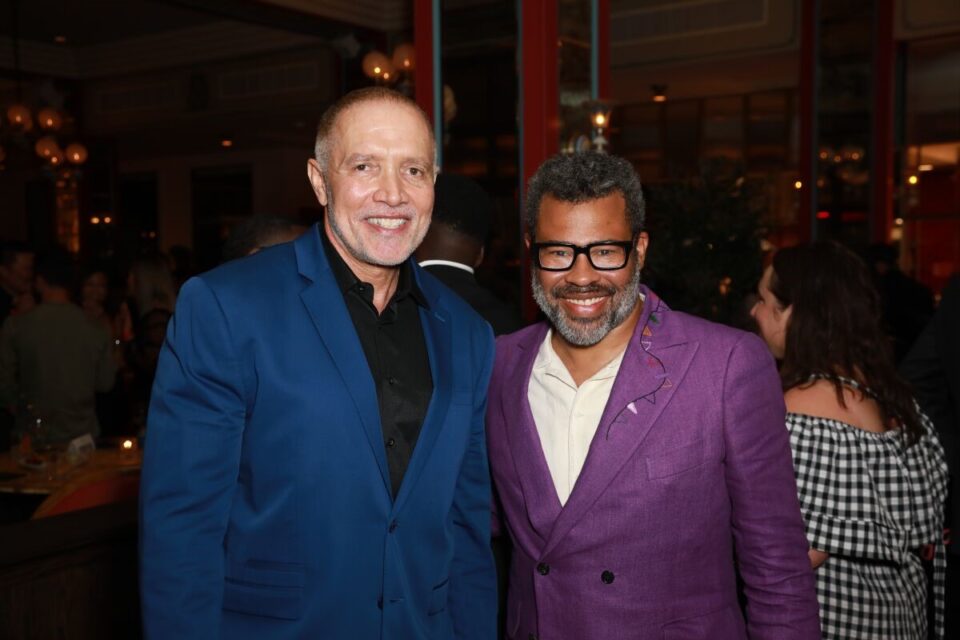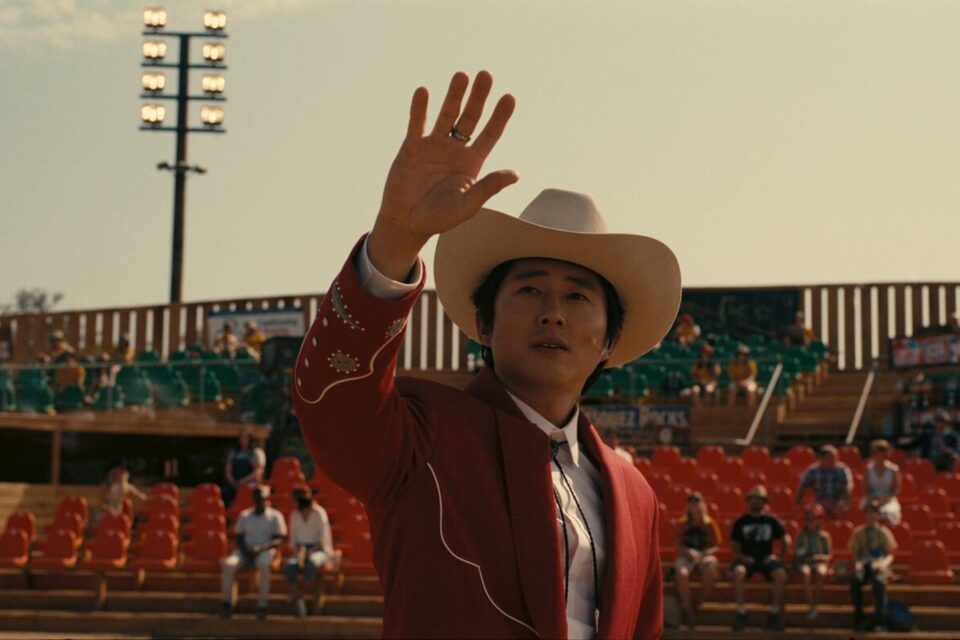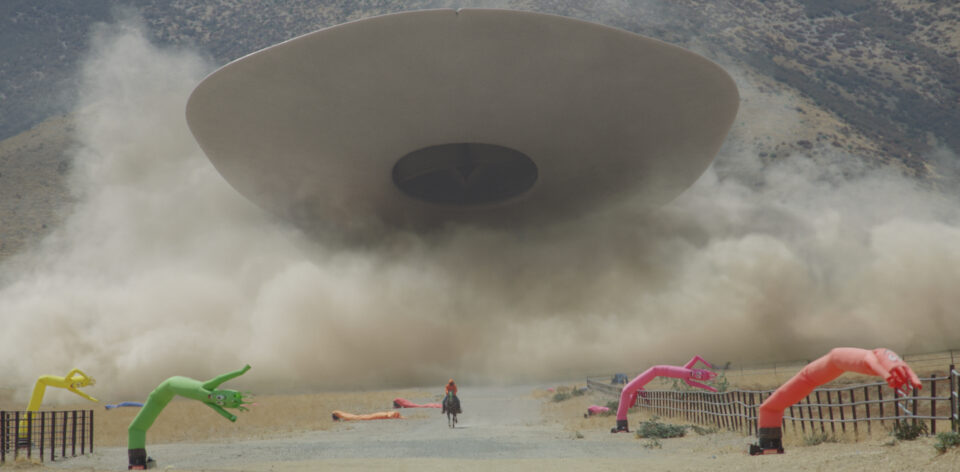Michael Abels and His Spectacular Score for ‘Nope’ [Terror on the Turntable]

Welcome to Terror on the Turntable! In this monthly column, join Rachel Reeves as she explores the powerful and unholy alliance between horror films and their scores. Covering only scores released on vinyl, it’s a conversation about the intersection of music theory, composer style, film history, and the art of deep listening. So, light the candles, put on your headphones, and get ready to drop that needle. The sacred ritual of listening to music on wax is about to begin. For this special Pride Month installment, Rachel gets sucked into Michael Abels’ score for Nope.
If one were to go back in time and ask composer Michael Abels if YouTube would ever change his life, it’s safe to bet that he would say, “Probably not.” And yet, that is exactly what happened. Before the world became introduced to Director Jordan Peele, his Oscar-winning screenplay for Get Out, doppelgangers and Jean Jackets, Peele went down a YouTube rabbit hole looking for a new, exciting musical partner. Who he found was Michael Abels. While all three of their collaborations so far have been notable, it is Nope that best celebrates the dynamic duo and what makes their pairing, particularly affecting.
Having been fascinated with music and composing since childhood, Abels’ choice to pursue composition at the USC Thornton School of Music surprised no one. This path led to a career in the more traditional classical music sphere. Balancing teaching, commissions and composing original concert works, music managed to pay the bills, which is a feat in and of itself. However, despite dabbling in commercial music and being interested in film scoring, breaking into the field proved tricky for Abels. That is, until Jordan Peele called.

For Peele, finding the right composer to score Get Out was paramount. As a huge cinephile, Peele knows how important a good score is to a film, and he did not take this decision lightly. He wanted a fresh voice and someone who would bring a unique perspective to the film’s duality, complexity, and commentary while fully supporting its emotional undercurrent. After watching a performance of Abel’s piece “Urban Legend,” performed by the Harlem Quartet and the Sphinx Symphony on YouTube, Peele knew he had found the voice he was looking for.
“I knew he was capable of creating a chimera effect of music genre, to take what, to me, sounded like jazz and western score and sweeping Chinese epic — and combine it into this new flavor. That’s what I wanted to do with ‘Get Out’ and ‘Us.’ I wanted a new flavor of film. I wanted a new flavor of thriller.”
– Jordan Peele (2022, Los Angeles Times)
What’s a Bad Miracle?
This idea of juxtaposition and dichotomy is one that Peele has also routinely explored, with Nope being no exception. In multiple interviews, Abels has described this recurring fascination for Peele as “one part ‘oh, shit’ and one part ‘oh my God.” Here, OJ (Daniel Kaluuya) and Emerald (Keke Palmer) Haywood are siblings with very different personalities. Like the two sides of the fateful nickel that falls from the sky and takes their father’s life, they may have differences but remain inextricably linked. Soon, the pair discover something otherworldly (literally) hiding in the clouds above the ranch with less than innocent motives, cementing this bond and laying it bare for all to see.
Abels infused the notion of duality into the music from the beginning to support this idea. When we first meet OJ and Otis Sr. (Keith David), the track “Haywood Ranch” plays. Subtle droning strings anchor deliberate, higher-pitched two-chord progressions. Giving each grouping ample time to breathe, each pair acts as a single unit, some moving upward, others down, leaning into dissonance and back again. Then, solo woodwind and brass introduce a relaxed, conversational melody while moving in tandem. Though singular instruments, the fact they are from different instrument families reinforces the concept slightly differently. Also returning in “Brother Sister Walk,” Abels beautifully encapsulates the Haywood family dynamic while coyly hinting at the vague threat yet to come.

An Absolute Spectacle
When pulling on this thread, the themes of perception and spectacle quickly follow. While there are many reads and layers to this, today’s focus is how life imitates art, which so often imitates life. To boil this down in how it relates to the music, let’s first look at the Old West theme park Jupiter’s Claim, owned by former child star Jupe Park (Steven Yeun). Kitschy and campy, Jupe embraces the absurdity and pumps vibrant, cinematic music from speakers around the park. Without this element, wandering around the park would feel odd. But with the music, Jupiter’s Claim suddenly becomes an experience.
Using classic Western film scores like The Good, the Bad and the Ugly and The Big Country as inspiration, Abels created original music for Jupiter’s Claim. Bold and full of brass (atypical for a Peele/Abels score), the track “Jupiter’s Claim” oozes adventure, fun, heroism, and positive nostalgia. Similarly, its partner track “The Star Lasso Expeeerrriii…” starts by building excitement through sweeping melodic strings and fluttering flutes before slowing like a record player losing power due to, oh, I don’t know…a mysterious UFO getting near?
Cleverly, by intentionally exaggerating these classic cliches, the music helps blur the line between the picturesque and the improbable, the cinematic and reality, and our cultural obsession with the dramatic. Just like how Jupe would rather discuss an SNL skit than his own Gordy experience or how Em confuses The Scorpion King with a Western, perspective can help one either catch the cloud that never moves with ease or overlook the anomaly entirely. While in the context of the film, this theme serves narrative and subtextual purposes, Abels extends this idea of perception projection to the audience as well.
Why Aren’t You Filming This?
On top of the obvious Western and horror elements, Nope is a sci-fi film. With that fact comes a whole lot of history and musical associations. Traditionally, science fiction, outer space, the otherworldly, and the unknown are often musically represented by synths or other forms of electronic music. Literally devoid of human breath or the physical interaction of strings or percussion, this cold association makes sense. Pushing against this stereotype, Peele and Abels decided to go a different way with Nope and the entity known as Jean Jacket.
More interested in elemental music (music centered around the body), Abels grounds Jean Jacket’s presence by focusing more on how its presence is perceived than just JJ itself. For example, in “It’s in the Cloud” and “Blood Rain,” Abels creates an intense feeling of instability and unease by employing an aleatoric effect in certain moments. A controlled kind of chaos, the random, unpredictable result especially prevalent in strings and brass, is one horror fans are very familiar with. Then coupled with intentional space, voices singing wordlessly, flutes, and bursts of brass, the overall vibe draws viewer attention upward with an intense sense of awe, dread, and terror while placing them firmly in our character’s shoes. It’s a subtle creative decision and distinction but a powerful one nonetheless.

Five Stars, Angel. Five Stars.
If you’re not obsessed with Abels and Peele yet, just wait. In a moving, full-circle moment, the track “The Run (Urban Legends)” accompanying OJ’s brave, climactic hero moment is taken from the same piece Peele discovered on YouTube, composed way before the duo even met.
“That was music I wrote that Jordan listened to when he wrote this script, actually. I think he imagined this scene with that music. I was a little skeptical — I was afraid that it would be too much fun. But when he temped it in, we were both amazed. It just shows how great he is at visualizing his entire finished product, even when he’s just typing it out for the first time.”
– Michael Abels (2022, IndieWire)
Seamlessly blending into Nope, the inclusion of “Urban Legends” beautifully aligns with the themes Abels and Peele love to explore together. It also encapsulates their symbiotic professional relationship. Despite originating from different creative fields, their combined efforts support and synergize in a way that can only be described as spectacular.
Now one of the most in-demand composers in film, Abels has decided to use his new platform to amplify and support others. In an effort to pay Peele’s initial gesture forward, Abels has helped create the Composers Diversity Collective, an advocacy and resource group whose goal is to increase the visibility and dispel misconceptions of music creators from culturally diverse backgrounds. Like Jean Jacket’s cloud, talented queer and culturally diverse music creators have always been there; Abels and his fabulous team are simply helping the industry finally see them.
Crate Digging
Continuing their relationship with Peele and Abels, Waxwork Records released both a CD and 2xLP of Nope’s score following the film’s release. Previously, the popular soundtrack label had also released Abels’ score for Get Out and Us. This release features stunning original artwork by Ethan Mesa, multiple 180-gram colorways, a booklet, production photos, and liner notes written by the multi-hyphenate wonder Tyree Boyd-Pates. As such, it does the seemingly impossible — it does Nope justice.
Categorized:Editorials Terror On The Turntable
